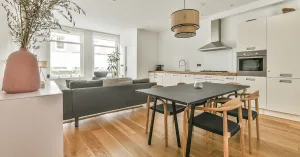“How much does it cost to install a wood floor?” is a direct question and one I get asked frequently. Unfortunately, giving a direct answer can be challenging. Every home is different. Considerations include the type of subfloor, its flatness, the moisture content of the slab, whether skirting boards will remain or need removal, and whether the floor will be glued or floated. Like most things, you get what you pay for. Investing a bit more in installation can ensure your floor lasts a lifetime.
You’ve purchased a beautiful new wood floor – what’s next? Maybe you have a carpenter friend offering help over the weekend. While that might be tempting, ask yourself if they have the requisite expertise. Handling a pre-finished wood floor requires skill and patience to avoid scratches during installation. Are they familiar with high-quality floor glue? Do they understand how to level a subfloor, identify a damp one, or seal a slab effectively? Moreover, will the sealer used be of high quality, or might it degrade prematurely? Attention to detail, like ensuring staggered end joints, is crucial. Just because someone is a carpenter or handyman doesn’t make them an expert floor installer. Mastery of this craft often takes years of dedicated practice.
Consider the following factors
Type of Installation
Floating: This method involves laying engineered wood planks without direct adhesion to the subfloor. Instead, they’re clicked together, often over an underlayment. It’s generally less expensive, with costs typically ranging from $35-45 per m². However, it’s not our recommended approach due to its shorter lifespan and the less solid feel underfoot.
Direct Stick (Gluing): Here, engineered wood planks are glued directly to the subfloor. This method provides a more substantial and authentic feel underfoot, but it’s pricier, with costs between $40-65 per m². The cost varies based on the installer’s skill. An experienced installer can pre-empt potential issues and will use the best tools and adhesives suitable for the task.
Subfloor Type
Wood: If it’s in good shape, installing on a wooden subfloor is usually straightforward. But necessary repairs or levelling can add to the expense.
Concrete: Such subfloors might need moisture barriers or specific underlay’s, especially in damp-prone areas. This consideration might increase costs but will ensure your floor’s longevity.
Quality of Materials
The choice of underlayment and adhesive significantly impacts the floor’s durability. Superior underlayment offers soundproofing, cushioning, and protection against moisture. Top-grade glues provide a robust bond. Opting for cheaper materials may be tempting, but investing in quality often means a longer-lasting floor. Glue costs can vary from $7-15 per m², and underlay ranges from $2-6 per m².
In Summary
The cost of a wood floor isn’t just about the planks. The method of installation, the state of the subfloor, and the quality of auxiliary materials all influence the end result. Always get multiple quotes and ensure you understand what’s included to get the best value for your money.
Natural Wood Floors:
Our commitment to quality is unwavering. Our installers are well-trained, articulate, and use the best adhesives, ensuring consistently excellent results. On the rare occasion that an issue arises, it’s addressed promptly and effectively. We’re also proud members of the Australasian Timber Floor Association, holding ourselves to high standards of integrity and excellence. We invite you to consider us for your next flooring project.


